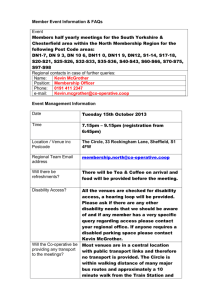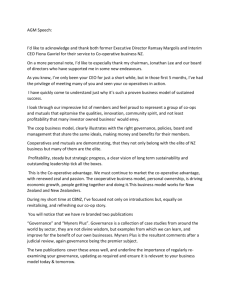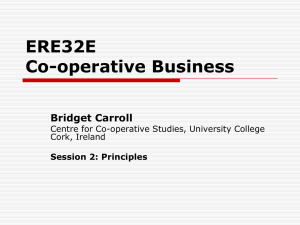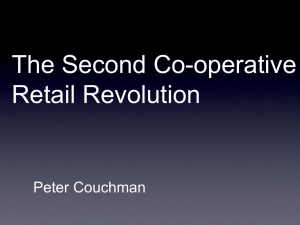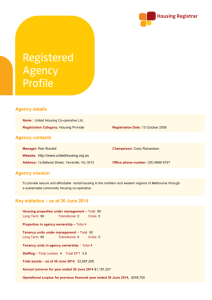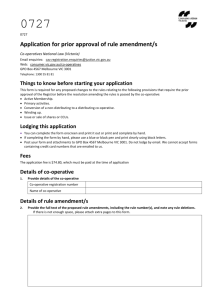Introduction to FairShares V2.1
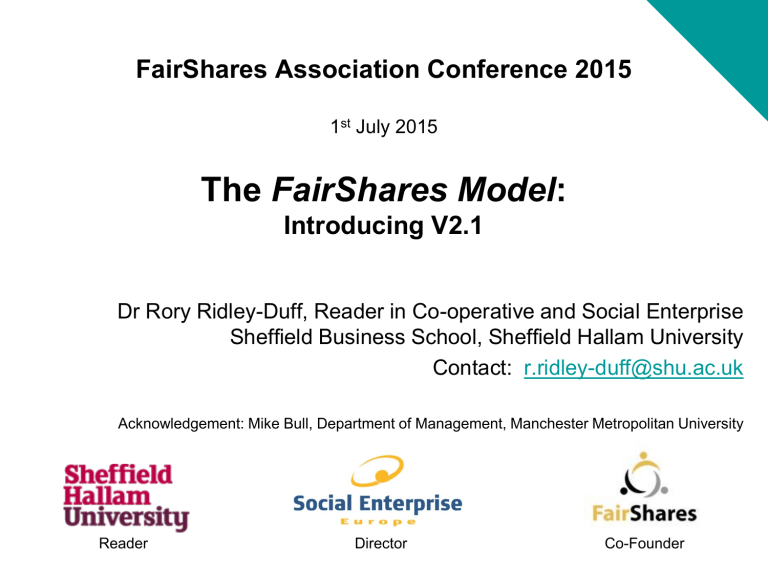
FairShares Association Conference 2015
1 st July 2015
The FairShares Model :
Introducing V2.1
Dr Rory Ridley-Duff, Reader in Co-operative and Social Enterprise
Sheffield Business School, Sheffield Hallam University
Contact: r.ridley-duff@shu.ac.uk
Acknowledgement: Mike Bull, Department of Management, Manchester Metropolitan University
Reader Director Co-Founder
The relevance of the FairShares Model
• “FairShares is a method of paying a return to the creators of intellectual and social capital within the enterprise and the wider network. It looks initially like a method of financing but it is, through the mechanism of issuing shares to workers and users based on participation, a way of gradually transferring some of the control of the organisation (and of all its various capitals) to the providers of intellectual and social capital, treating them as equal to the providers of financial capital. Furthermore, just as the providers of financial capital retain ownership of their contribution, by using Creative
Commons licensing FairShares allows the contributors of intellectual capital to retain ownership of their contribution .”
• Maureen McCulloch, Submission to ICAEW, May 2014
In this presentation, I will…
• Briefly set out the theoretical/historical underpinnings of FairShares
– Its historical and intellectual antecedents…
– Its current and future trajectory…
• Report on key developments in the second year of FairShares
– Refined diagnostic tools (using Toluna technology)
– Redeveloped Wiki / Website (using MediaWiki / Wordpress technologies)
– A Finalised Data Model (by Steve Wagstaff)
– New Branding for the Three Step Model (by Rory Ridley-Duff)
– Supporters, members and partners.
• Identify ‘core’ IP that will generate (social) value
Underpinning Social Enterprise Theory
• In 2012, Cliff and I did research on The Social Enterprise
Mark in which we tracked past and present traditions using the concepts of ‘socialisation’ and ‘social purpose’:
– Socialised enterprise (pluralist) as a process of developing public/social rights so that primary stakeholders* become owners and controllers of (financial, social and human) capital, and;
– Social purpose enterprise (unitary) as the pursuit of public/community benefit through business activity driven by social goals.
– FairShares V2.1 advances a ‘socialised form’ for a ‘social purpose enterprise’ – both means and ends matter.
* Producers, Employees, Consumers and Service Users
Ridley-Duff, R. J. and Southcombe. C. (2012) “The Social Enterprise Mark: a critical review of its conceptual dimensions”, The Social Enterprise Journal, 8(3): 178-200
Approaches to Social Enterprise
• Charitable / NGO Trading (Associations)
• Charitable trading for community / public benefit with no share capital . Divided broadly into:
Foundations – more mission driven ( social purpose )
Associations – more member-driven ( socialised )
• Co-operative / Mutual Enterprises (Co-operatives)
• ICA compliant co-operative societies based on reciprocity , mutuality and solidarity with members’ share capital and trading activities.
• Socialised enterprises that are member-owned, often – but not necessarily
– also specifying their social purpose(s).
• Social Firms / Businesses (Companies)
• The adaptation of private/non-profit companies to enhance ethics, sustainability and responsibility but without statutory regulation of social purpose(s) or a commitment to adopting a socialised form.
FairShares: historical and intellectual antecedents
Source: RidleyDuff and Bull (2014) “An embedded communitarian pluralist approach to social enterprise development”, submission to Business History Journal.
FairShares: current and future trajectories
Source: RidleyDuff and Bull (2014) “An embedded communitarian pluralist approach to social enterprise development”, submission to Business History Journal.
Key Developments:
Research-Informed Diagnostics
• FairShares V2.1 includes updated diagnostics developed during a research programme undertaken at Sheffield Hallam University and
Manchester Metropolitan University:
– Social Auditing / Diagnostics tools built on work with Cliff Southcombe / SEE.
– Participation Auditing / Diagnostics built on work with Alistair Ponton.
– Governance Auditing / Diagnostics build on work with Tracey Coule / Mike Bull.
We should not forget to acknowledge the support and critical feedback of
Christine Gilligan, Anthony Bennett, Adrian Ashton and many, many other students at
SBS for their help in developing and testing each of the research instruments.
By way of example, you will have received a link to a FairShares Social Enterprise
Survey – one of the Level 1 Diagnostics
– let’s look at the results ….
A redeveloped Wiki:
Using MediaWiki (Wikipedia) Technology
• FairShares V2.1 includes an updated Wiki :
– Section on updates in Version 2.x.
– All Supporters and Members entitled to read/write access.
– Problems with Spam prevent giving full public access.
• Supports collective development of support documentation
• Repository of technical documentation
• Is getting a reasonable level of attention in cyberworld:
– Over 29,500 views of the FairShares Home Page since creation
– Over 8,800 views of the FairShares Model page
Redeveloped Web Resources:
Using Wordpress / Loomio Technologies
• FairShares V2.1 includes a redesigned new website , to explain the
Why, What and How of FairShares ( www.fairshares.coop
):
– Retained the URL http://www.fairshares-association.com/ as a web portal for easy access to subscriptions, donaion and e-mail registration.
– Website provides access to shared versions of the diagnostics .
• Vehicle for sharing ‘News’ and to ‘Blog’ about FairShares.
– Can share pages, news, and articles on Twitter, Facebook, LinkedIn and Gmail
• Now added a FairShares Association Loomio Group for Online
Debate / Voting.
– Community Forum, Founder, Labour Members and User Members sub-groups
• Now added a Loomio FairShares Model Enterprise to give people hands-on experience of FairShares.
A FairShares Data Model
FairShares Social Enterprises Data Model v3.1 10 April 2013. Revision after informal review by FairShares Association.
Trade/Business
Classification
Incorporation
Type
FairShares Model
Variant
Membership
Type b b
Person Organisation
Trade/Business Incorporation
Membership
Type Attribution
Membership a a
Social Enterprise b a by of provided by received by
Resource
Contribution
Organisation
Type
Value/Principle
Espousal
Social Purpose Social Impact Share Issue c
Surplus
Distribution
Period
Contribution
Reward
Contribution
Type
Value/Principle
Data with public read-only access
Social Purpose
Classification
Social Impact
Classification
Data private to the social enterprise
Reward Tariff
Share Type Reward Type
Alternative relationships: a a Resource Contribution to a Social Enterprise must be provided by one and only one of: a Person, (another) Social Enterprise or an Organisation
b a member of a Social Enterprise must be one and only one of: a Person,
(another) Social Enterprise or an Organisation
A Three-Step Model to Explain FairShares
Source: www.fairshares-association.com/wordpress/fairshares-model
A Three-Step Model: From Step 1 to Step 2
A Three-Step Model: From Step 2 to Step 3
Supporters, Members and Partners
• Any supporter can apply for membership if they make this qualifying contribution:
“A substantial and lasting contribution to the development of the FairShares Model or
FairShares Association”
– Qualifying contribution for Labour Membership is peer-reviewed by existing members
– Qualifying contribution for User Membership by creating a FairShares Enterprise or signing a
Social Licence Agreement to develop FairShares.
– User Membership set to grow as SEE renews social licence agreements (we signed one with the SLAP Association for Creative Development in Croatia on 15 th June).
(A Social Licence Agreement is a three way agreement between Social Enterprise Europe, the FairShares Association and your enterprise to develop or spread usage of the FairShares Model)
What is the ‘Core IP’ in FairShares?
• Core IP - Creative Commons (BY-NC-SA) Licence 4.0
Can share/adapt for non-profit use only, can commericalise only by agreement. Main options for generating income?
– Diagnostics (purchases of private copies)
– Data Model (subscriptions to use an ICT system based on it)
– Model Rules (for new Associations, Co-operatives and Companies)
– Courseware?
– Financial Modelling / Planning Services?
• Other IP – Creative Commons (BY-SA / BY-ND) Licence 4.0
Can freely share/adapt for non-profit / commercial use
– FairShares Wiki / Website Content (Online Content)*
– FairShares explanatory documentation (PDF Format)
– FairShares presentation materials
* Unless stated otherwise
Summary: The FairShares Model
• FairShares Version 2.1 (1
st
July 2015):
– A set of brand principles
– Seven diagnostic tools for social auditing, learning and research
– Model rules for associations, co-operatives and companies
– A wiki and website with supporting documentation / information
• What is FairShares to you?
– A multi-stakeholder model for (co-operative) social enterprises?
– A methodology for social enterprise creation?
– A new philosophy for social economy development?
References
•
Amin, A. (2009) The Social Economy: International Perspectives on Economic Solidarity, London: Zed Books.
• Birchall, J. (2011) People Centred Businesses: Co-operatives, Mutuals and the idea of Membership, Basingstoke:
Palgrave Macmillan
•
Birchall
, J. (2012) “A member-owned business approach to the classification of co-operatives and mutuals”, in
McDonnell, D. and Macknight, E. (eds) (2012), The Co-operative Model in Practice, Glasgow: Co-operative
Education Trust, pp. 67-82.
• Brown, J. (2004) Cooperative Capital: A New Approach to Investment in Cooperatives and Other Forms of Social
Enterprise , Manchester: Cooperative Action.
• Brown, J. (2006) “Equity finance for social enterprises”,
Social Enterprise Journal, 2(1): 73-81.
• Bull, M. (2007). Balance: The development of a social enterprise business performance analysis tool. Social
Enterprise Journal , 3(1), 49 –66.
• Bull, M., & Crompton, H. (2006). “Business practices in social enterprise”, Social Enterprise Journal , 2(1): 42 –60.
• Cathcart, A. (2009) Directing Democracy: The case of the John Lewis Partnership, unpublished PhD Theses,
School of Management: University of Leicester.
• Cathcart, A. (2013) “Paradoxes of participation: non-union workplace partnership in John Lewis”,
International
Journal of Human Resource Management , earlycite at DOI:10.1080/09585192.2012.743476.
• Chadwick-Coule, T. M. (2011) "Social Dynamics and the Strategy Process: Bridging or Creating a Divide between
Trustees and Staff", Non-Profit and Voluntary Sector Quarterly , 40(1): 33-56.
• Chell , E. (2007) “Social enterprise and entrepreneurship: towards a convergent theory of the entrepreneurial process”, International Small Business Journal , 25 (1): 5-26.
•
Coad, A. and Cullen, J. (2001) The Community Company: Towards a Competencies Model of Corporate
Governance , Paper to 5th International MCA Conference , July 4-6, London.
• Crowder, G. (2006) “Value Pluralism and Communitarianism”,
Contemporary Political Theory , 5(4): 405-427.
• Driver and Martin (1997) “New Labour’s Communitarianisms”, Critical Social Policy, 17: 27-46.
• Ellerman, D. (1997) The Democratic Corporation, Beijing: Xinhua Publishing House. First published as ‘The
Democratic Firm’ in 1990.
References
•
Erdal, D. (2011) Beyond the Corporation: Humanity Working: London: The Bodley Head
• Gates, J. (1998) The Ownership Solution . London: Penguin.
• Holyoake, G. (2013) The History of Co-operation, Hardpress Publishing. [First published 1877].
•
Lewis, J.S. (1948) Partnership for All: A Thirty Four Year Old Experiment in Industrial Democracy , London: Kerr-
Cross Publishing.
•
Lewis, J.S. (1954) Fairer Shares: A possible advance in civilization and perhaps the only alternative to
Communism , London: Staples Press Ltd.
• Owen, R. (1816) A New View of Society, Kindle Edition.
•
Reeves, R. (2007) CoCo Companies: Work, Happiness and Employee Ownership, London: Employee Ownership
Association.
• Ridley-Duff, R. J. and Bennett, A, (2011) "Towards Mediation: developing a theoretical framework for understanding alternative dispute resolution", Industrial Relations Journal , 42(2): 106-123
• Ridley-Duff, R. J., Cullen, J., Beeby, P. and Norris, R. (2003), Enterprise for Communities: Proposals for a
Community Interest Company , Submission to government by Sheffield Hallam University/School Trends Ltd, 15th
June 2003, downloaded from http://www.scribd.com/doc/13647544/ on 21 November 2009.
• RidleyDuff, R. J. (2007) “Communitarian perspectives on social enterprise”, Corporate Governance: An
International Review , 15(2): 382-392.
• Ridley-Duff, R. J. and Bull, M. (2011) Understanding Social Enterprise: Theory and Practice, London: Sage
Publications.
• RidleyDuff, R. J. (2012) “New frontiers in democratic self-management”, in McDonnell, D. and Macknight, E.
(eds), The Co-operative Model in Practice, Glasgow: Co-operative Education Trust, pp. 99-117.
• Ridley-Duff, R. J. and Southcombe. C. (2012) “The Social Enterprise Mark: a critical review of its conceptual dimensions”, The Social Enterprise Journal, 8(3): 178-200.
•
Ridley-Duff, R. J., Southcombe, C. and Dickins, N. (2013) FairShares Model - Introduction , Sheffield: FairShares
Association, downloaded from www.fairshares.wikispot.org
.
• RISE (2009) Social Enterprise Mark – Qualification Criteria: Issue 3, January 2009, Exeter: RISE.
References
• Romme, A. (1999), "Domination, self-determination and circular organizing", Organization Studies , 20(5): 801-832.
• Romme, A., and G. Endenburg (2006). "Construction principles and design rules in the case of circular design", Organization Science , 17(2): 287-297.
• Scott-Cato, M., Arthur, L., Keenoy, T., Smith, R., (2008) "Entrepreneurial energy: associative entrepreneurship in the renewable energy sector in Wales", International Journal of Entrepreneurial Behaviour and Research , 14(5):
313 – 329.
• Smith, G. and Teasdale, S. (2012) "Associative democracy and the social economy: exploring the regulatory challenge", Economy and Society, 41(2): 151-176.
•
Spreckley, F. (1981) Social Audit
– A Management Tool for Co-operative Working
, Leeds: Beechwood College.
• Turnbull, S. (1994), “Stakeholder democracy: redesigning the governance of firms and bureaucracies”,
Journal of
Socio-Economics , 23(3): 321-360.
• Turnbull, S. (1995) “Innovations in Corporate Governance: The Mondragon Experience”, Corporate Governance:
An International Review, 3(3): 167-180.
• Turnbull, S. (2002) A New Way to Govern: Organisations and Society after Enron, London: New Economics
Foundation.
• Vinten , G. (2001) “Shareholder versus Stakeholder – is there a governance dilemma?”, Corporate Governance:
An International Review , 9(1): 36-47.
• Westall, A. (2001) Value-led, Market-driven: Social Enterprise Solutions to Public Policy Goals, London: IPPR.
• Whyte, W. and Whyte, K. (1991) Making Mondragon, New York: ILR Press/Itchaca.
